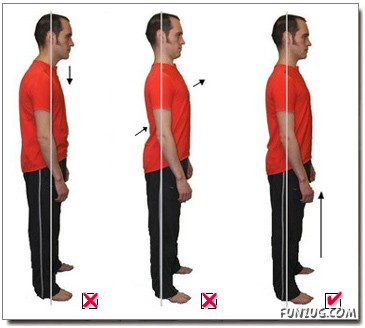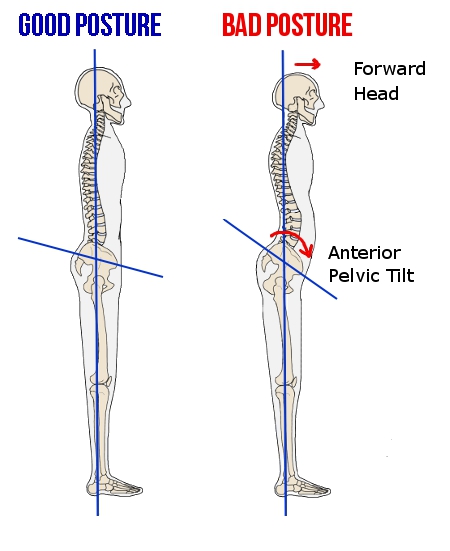 Posture. Your mother nagged you about it. Your teachers reminded you to quit slouching. Dance teachers go on and on about proper alignment.
Posture. Your mother nagged you about it. Your teachers reminded you to quit slouching. Dance teachers go on and on about proper alignment.
Why is this so important anyway?
Simple: When your body is aligned correctly:
- Your bones articulate smoothly
- Your muscles engage properly
- And best of all – you look thinner!
What’s not great about that?
Begin Good Posture with Your Legs
 Let’s start with your legs, the foundation of your structure. The center of your knees and ankles – the strongest part of the joints – should line up under the hip socket. That translates to approximately a fist-width of space between your feet. You can also line up the center of your heel under your sits bones in the back. Point the big toe as straight forward as you comfortably can. A little turnout is OK, but too much can cause major problems, especially with your feet and toes.
Let’s start with your legs, the foundation of your structure. The center of your knees and ankles – the strongest part of the joints – should line up under the hip socket. That translates to approximately a fist-width of space between your feet. You can also line up the center of your heel under your sits bones in the back. Point the big toe as straight forward as you comfortably can. A little turnout is OK, but too much can cause major problems, especially with your feet and toes.
Set the Posture of Your Core
Now place your hands on the front of your pelvis and find your hip bones & pubic bone. Line those three bones up in a triangle that is parallel to the wall in front of you. This is called neutral pelvis.
For most people, this is the safest position for your lower back and hip joint as they articulate with your pelvis. It is also the position in which the muscles of the abdominal wall, lower back, and hips can engage and work most effectively.
Align Your Bony Points
Now move up and place one hand on your sternum (breastbone) and line it up directly above your pubic bone. You have probably heard your dance teachers say “shoulders over hips” many times. This is basically the same thing – the six bony points on the front of your body (shoulders, hip bones, sternum, and pubic bone) should line up vertically. Spinal curves vary widely from person to person, so it is difficult to judge posture strictly from the back.
Upper Body Alignment
Lastly, place your hands on top of your shoulders and feel for a bony bump right above the center of your arm (acromion process). This point should be directly over the bony bump in the center of the side of your hip (greater trochanter).
Going up from there, the center of your ear should line up directly over the center of your shoulder, and from the side view, the tip of the nose should be level with the center of your ear. In other words, the lines from the shoulder to the ear and the ear to the nose should make a right angle.
Exercise While Aligned
Of course there are many more fine points to this as well as various injuries and structural issues that are exceptions to the rule. And nobody needs to stress over being absolutely perfect 100% of the time. But if you just take a minute or so each day to check your posture, you can build better awareness and increase your ability to correct your alignment.
Everyone knows that exercise is good for you, but exercising in poor alignment can cause more damage than good. If you had to choose between exercising in poor alignment or not exercising at all but maintaining good alignment, choose proper alignment. Hopefully, none of us will have to make that choice and we will dance, exercise, and live as much of our lives in good alignment as possible!
Joy Karley, MA, CPT
About Joy Karley
Joy Karley, MA holds a Master’s degree in Biomechanics and Athletic Training from San Diego State University and a Bachelor of Science in Modern Dance from Kent State University. Her background includes extensive training in classical ballet, jazz, tap, Latin, and theater dance.
Joy is also a Pilates Method Alliance Certified Pilates Teacher (PMA, CPT) and an AFAA & IFTA Certified Fitness Instructor & Personal Trainer. She teaches Pilates, fitness and dance classes throughout New York City.
FitEngine is your premier provider of inside information on the fitness industry and workout classes in NYC.
(Pics from Funzug.com and Greetings from Nolandia.com)



